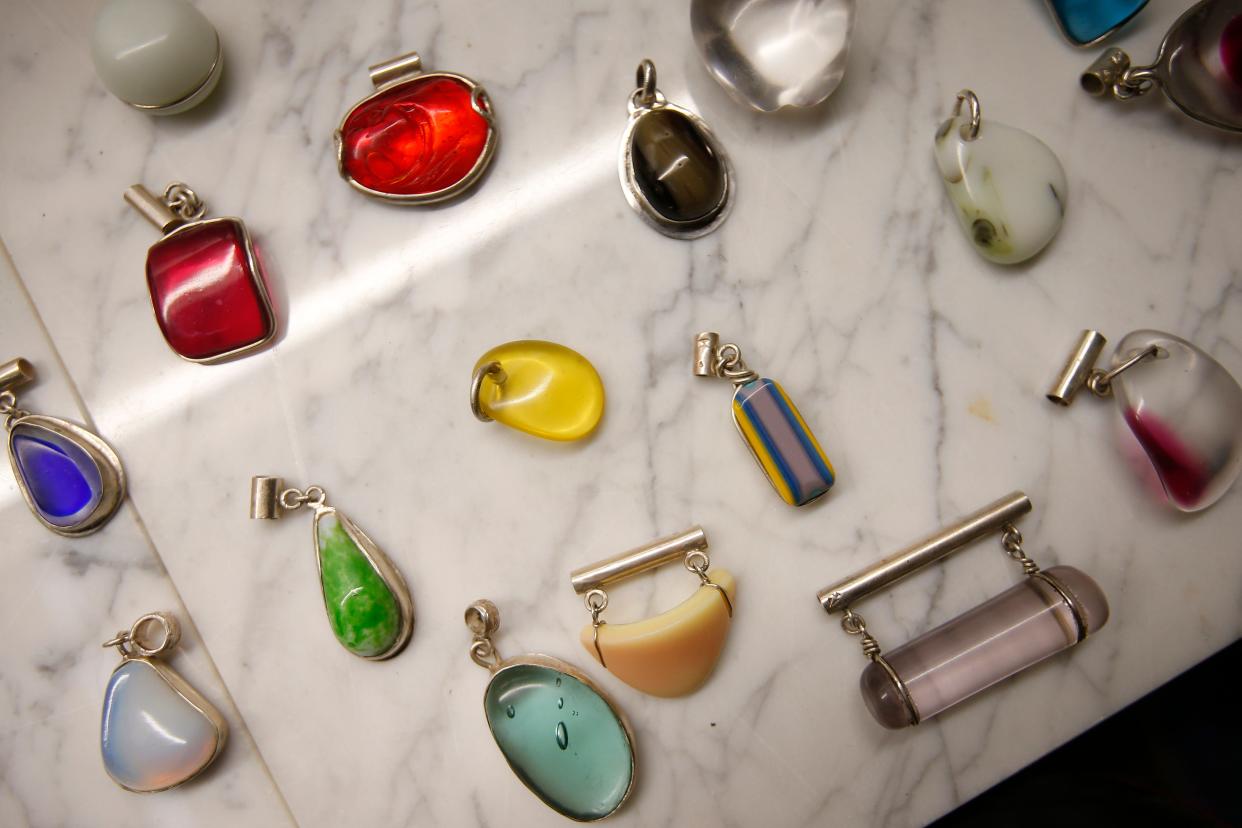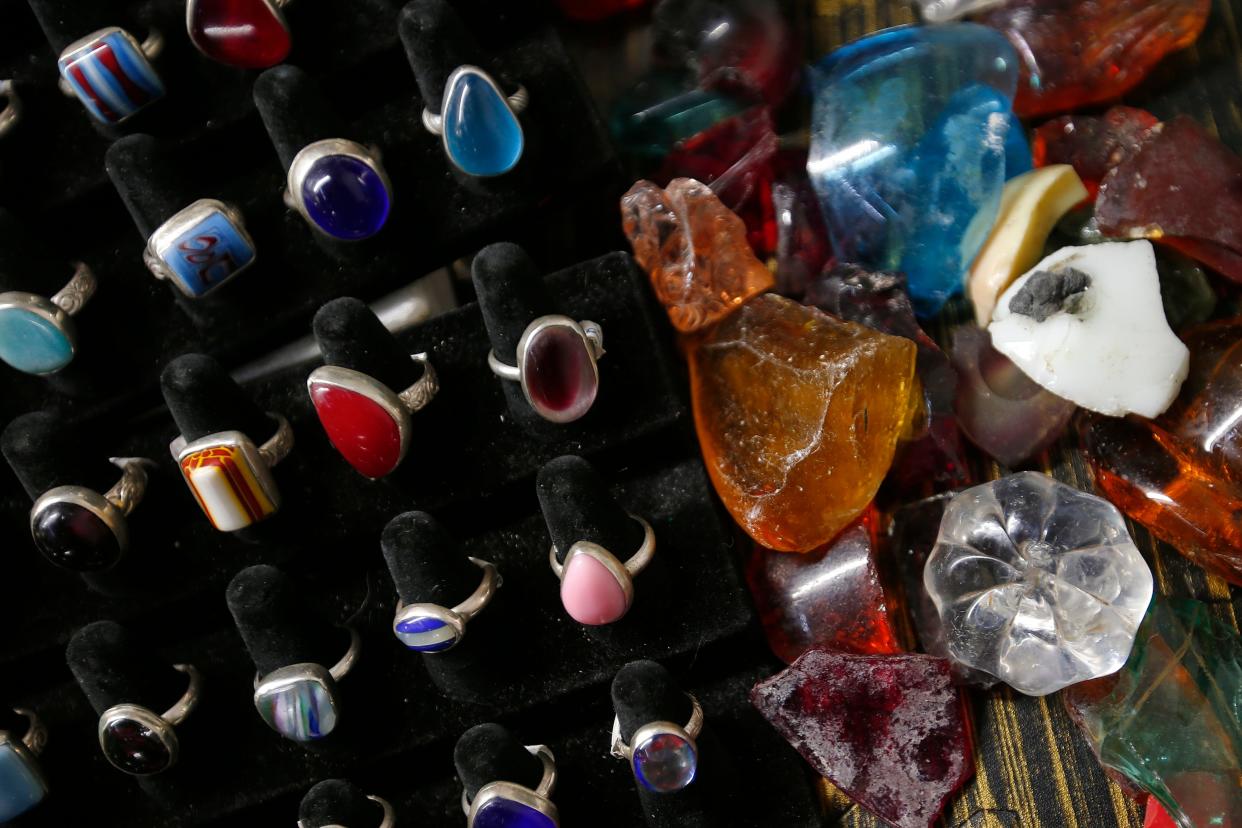This New Bedford jeweler's affinity for Pairpoint Glass results in history you can wear
NEW BEDFORD — It's been almost 60 years since the historic Pairpoint Glass mill fire of 1965, at 30-44 Prospect St. in New Bedford. And while a number of New Bedford's old industrial mills still stand as reminders of a bygone era, Pairpoint — which dubs itself "America's oldest glass company" — left traces of its presence in other ways.
One way was through the artfully finished pieces — all handblown and one-of-a-kind — that have made their way into museum displays and private collections throughout the country.
Another way was through the multitude of glass fragments and shards of all shapes, sizes and colors, spread about bountifully during the explosive fire, says Beth Kirk, owner of Kirk Studio and the Metalsmith shop in New Bedford.
"Some of it was from finished pieces, some was unfinished, some pieces you can tell were in the furnace at the time," Kirk said, pointing out the differences of some of the yet-to-be-used pieces of glass she makes into the jewelry and art pieces sold at her newly opened shop at Kilburn Mill. "If you know what you're looking at, every little piece tells a story."
Kirk, a former longtime New Bedford resident currently living in Fall River, has been using the largely disregarded Pairpoint fragments in her work since 2020, when the COVID pandemic suddenly granted her enough free time to add some artful new skills to her repertoire. But, she had already been putting her creativity to work since childhood.
Don't miss!: This Westport comedy event will benefit the local suicide hotline center. Read more.
"I started making things when I was five — I was making things out of toothpicks," Kirk said. "Then I went into clay, then jewelry, then stained glass ... and eventually back to metals; they're my favorite."
'Beautiful and historic'
While majoring in fine arts, Kirk says she was taught creating something attractive is one thing — creating something special is another. It's something she's taken to heart ever since, as evidenced through her current work which — aside from Pairpoint glass pieces — includes items crafted out of anything from antique marbles to World War II-era steel pennies.
"When I went to art school, they asked what I wanted to make, and I said beautiful things. They said that's not enough, and now I know what they meant — it's got to be beautiful and historic, beautiful and funny; something other than just beautiful," Kirk said, noting she's always got her eyes open for good finds she can work with.
Pairpoint's New Bedford story ended in buried treasure
The New Hampshire native says working with Pairpoint glass pieces — a main staple of her business — reflects the latest set of skills she's mastered, thanks to a sizable supply of broken chunks and shards indicative of Pairpoint's glass-making and blowing processes that had been buried in the area following the fire.
What do you think?: Teens, young adults charged with crimes could be retained in state juvenile justice system
"And not everything that was buried behind Pairpoint was from the fire — some of it was from the 1890s, 1900s," Kirk said, mentioning the two large jars she purchased in 2019 from a private Pairpoint dealer that had been recovered from someone's basement.

Clues that hint at certain steps in the process can be seen in pieces Kirk has, she said, noting she often takes care to preserve those subtle features in her finished work.
"Sometimes I save the pipe mark, where the pipe came off of the glass when it was being blown," she said pointing out a protrusion on one of her pendants, which she'd worked into its design. Another piece of glass, a thick chunk yet to be cut, carved or polished, had inconsistencies in shape and texture that show it was in the midst of being melted in a furnace when that process was interrupted, likely by the fire Kirk said.
A learning process
But being that broken Pairpoint fragments like the ones she works with aren't worth much money, Kirk said the job of cutting them into right-sized pieces wasn't profitable enough for craftsmen accustomed to cutting higher value materials. So, she had to learn the process herself through research and trial and error.
"The way I make my work, it takes me a long time but it's perfect," Kirk said. "I cut pieces with a tile cutter; then I carve it with diamond bits into the shape I want, in water so it doesn't crack; and then I use nine different wet/dry sandpapers to polish it, from 100 (grit) up to 3,000, and then I set it."
Mark your calendars: Whaling National Park to celebrate Black History Month. Here's what's happening this month
Typically, Kirk says her Pairpoint jewelry pieces are set in high-grade argentium silver, which is purer than more common sterling varieties. "It's a little whiter in color and doesn't tarnish as easily," she said.
All in all, Kirk said a single piece — such as a ring or pendant — averages about 14 hours to make.
What's special about Pairpoint glass?
Aside from the fact it came from such an important source in the histories of both glass-making and the city of New Bedford, Kirk says just a quick glance is enough to tell someone they're looking at something special.
One of the biggest differences between the antique glass made using the old Pairpoint methods and modern glass, Kirk said, is that many Pairpoint glass varieties contained heavy metals like lead and uranium, which contributed to their distinct look.
While it's difficult to explain the visual effect, Kirk describes it as creating "a smooth, yummy color."

"The lead added depth to the color. Even if it was clear, it was a rich, smooth clear," she said. "Without lead, it becomes more see-through and less... luscious, I'd say."
Varieties containing uranium will glow neon under ultraviolet light, Kirk said, so she keeps some UV flashlights handy at her shop to demonstrate this.
Kirk says she's been advised glass items containing such materials are generally safe to handle, but should not be ingested.
New shop at Kilburn Mill marks a new adventure
Perhaps it's fitting that items that originated in one of New Bedford's old mills are now being sold at another that's still standing.
Now about a month in after opening her and her husband Larry's brick and mortar location at Kilburn Mill — named "Metalsmith" and located within the Marketplace area on the second floor — Kirk says she's been excited to see her vision of a physical retail shop come together.
Looking ahead: Famous groundhog Punxsutawney Phil will give his prediction Friday: What will he say?
"We've been doing a lot of work, going in and making it look nice," she said, noting her husband's nautical stained glass work is also for sale there. "Our studio where we make everything is right around in back of the mill, so that makes it easy."
A labor of love
Understanding that there are cheaper, easier materials to work with that would turn a larger profit in less time, Kirk says she has no intent on stopping her Pairpoint gem-making craft.

"I'm not going to stop making Pairpoint," she said, though noting she also creates items from other materials like semi-precious stones to take a break from the labor intensiveness of antique glass. "It's not about the money. I love doing it, and there are people who do appreciate the history and all the work that went into it."
To browse some of her items online, visit the Kirk Studio Facebook page at www.facebook.com/bethkirkstudio.
Kirk's Metalsmith shop, located at Kilburn Mill, 127 W. Rodney French Blvd., second floor inside the Marketplace, is open Saturdays and Sundays, 10 a.m. to 4 p.m.
This article originally appeared on Standard-Times: New Bedford shop offers one-of-a-kind Pairpoint Glass jewelry
